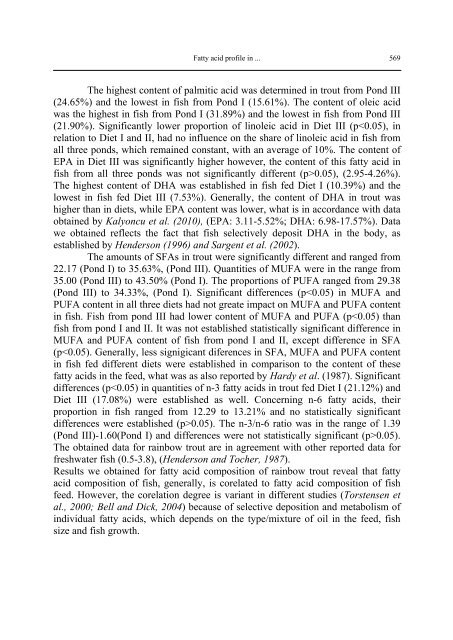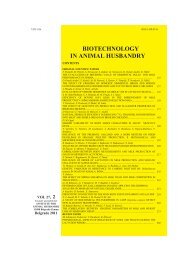- Page 1 and 2:
UDC636 Print ISSN 1450-9156 Online
- Page 3 and 4:
Journal for the Improvement of Anim
- Page 5 and 6:
Biotechnology in Animal Husbandry 2
- Page 7 and 8:
Shell quality - everlasting problem
- Page 9 and 10:
Shell quality - everlasting problem
- Page 11 and 12:
Shell quality - everlasting problem
- Page 13 and 14:
Shell quality - everlasting problem
- Page 15 and 16:
Shell quality - everlasting problem
- Page 17 and 18:
Biotechnology in Animal Husbandry 2
- Page 19 and 20:
Effect of feathering alleles (k/K +
- Page 21 and 22:
Effect of feathering alleles (k/K +
- Page 23 and 24:
Effect of feathering alleles (k/K +
- Page 25 and 26:
Effect of feathering alleles (k/K +
- Page 27 and 28:
Biotechnology in Animal Husbandry 2
- Page 29 and 30:
The effect of phase nutrition durin
- Page 31 and 32:
The effect of phase nutrition durin
- Page 33 and 34:
The effect of phase nutrition durin
- Page 35 and 36:
The effect of phase nutrition durin
- Page 37 and 38:
Biotechnology in Animal Husbandry 2
- Page 39 and 40:
Egg quality of japanese quail ... e
- Page 41 and 42:
Egg quality of japanese quail ... I
- Page 43:
Egg quality of japanese quail ... H
- Page 46 and 47:
434 E. N. Uchewa et al. an average
- Page 48 and 49:
436 E. N. Uchewa et al. days the ex
- Page 50 and 51:
438 E. N. Uchewa et al. Uticaj kva
- Page 53 and 54:
Biotechnology in Animal Husbandry 2
- Page 55 and 56:
Estimation of the relative bioavail
- Page 57 and 58:
Results and discussion Estimation o
- Page 59 and 60:
Estimation of the relative bioavail
- Page 61 and 62:
Estimation of the relative bioavail
- Page 63 and 64:
References Estimation of the relati
- Page 65:
Estimation of the relative bioavail
- Page 68 and 69:
456 V. Vidovic et al. existing sele
- Page 70 and 71:
458 V. Vidovic et al. All the facto
- Page 72 and 73:
460 Conclusion V. Vidovic et al. Th
- Page 74 and 75:
462 V. Vidovic et al. VIDOVIC V. (1
- Page 76 and 77:
464 Č. Radović et al. Radović et
- Page 78 and 79:
466 Č. Radović et al. Table 3. Th
- Page 80 and 81:
468 Č. Radović et al. CHAN D. E.,
- Page 82 and 83:
470 M. Popovac et al. Most frequent
- Page 84 and 85:
472 M. Popovac et al. Roehe and Ken
- Page 86 and 87:
474 M. Popovac et al. heritability
- Page 89 and 90:
Biotechnology in Animal Husbandry 2
- Page 91 and 92:
Table 1. Composition of diets for p
- Page 93 and 94:
Meat fatty acid profile of ... Tabl
- Page 95 and 96:
Meat fatty acid profile of ... SFA
- Page 97 and 98:
Rezime Meat fatty acid profile of .
- Page 99 and 100:
Biotechnology in Animal Husbandry 2
- Page 101 and 102:
Material and methods The effect of
- Page 103 and 104:
The effect of the level of milk ...
- Page 105 and 106:
The effect of the level of milk ...
- Page 107 and 108:
The effect of the level of milk ...
- Page 109 and 110:
Biotechnology in Animal Husbandry 2
- Page 111 and 112:
Results of the biological... al.,(1
- Page 113 and 114:
Results of the biological... Table
- Page 115 and 116:
Results of the biological... highly
- Page 117 and 118:
Results of the biological... In vie
- Page 119:
Results of the biological... perspe
- Page 122 and 123:
510 R.T. Gudaj et al. Companies dea
- Page 124 and 125:
512 Results and Discussion R.T. Gud
- Page 126 and 127:
514 R.T. Gudaj et al. blame cows th
- Page 128 and 129:
516 R.T. Gudaj et al. RUTHERFORD K.
- Page 130 and 131: 518 M.P.Petrovic et al. some author
- Page 132 and 133: 520 M.P.Petrovic et al. Table 1. So
- Page 134 and 135: 522 M.P.Petrovic et al. In the Medi
- Page 136 and 137: 524 M.P.Petrovic et al. The signifi
- Page 138 and 139: 526 M.P.Petrovic et al. AL-SHOREPY
- Page 140 and 141: 528 M.P.Petrovic et al. PETROVIC, P
- Page 142 and 143: 530 D. Ružić-Muslić et al. In th
- Page 144 and 145: 532 D. Ružić-Muslić et al. with
- Page 146 and 147: 534 Conclusion D. Ružić-Muslić e
- Page 148 and 149: 536 D. Ružić-Muslić et al. RODRI
- Page 150 and 151: 538 Introduction Z. Ilić et al. In
- Page 152 and 153: 540 Z. Ilić et al. the lowest weig
- Page 154 and 155: 542 Z. Ilić et al. 31.60%, while t
- Page 156 and 157: 544 Z. Ilić et al. HOSSEINI S. M.
- Page 158 and 159: 546 J. Stojković et al. ammonia, c
- Page 160 and 161: 548 J. Stojković et al. Throughout
- Page 162 and 163: 550 Conclusion J. Stojković et al.
- Page 164 and 165: 552 J. Stojković et al. STOJKOVIĆ
- Page 166 and 167: 554 M. Joksimović Todorović et al
- Page 168 and 169: 556 M. Joksimović Todorović et al
- Page 170 and 171: 558 Acknowledgment M. Joksimović T
- Page 172 and 173: 560 M. Joksimović Todorović et al
- Page 175 and 176: Biotechnology in Animal Husbandry 2
- Page 177 and 178: Fatty acid profile in ... Zlatibor,
- Page 179: Fatty acid profile in ... Table 1.
- Page 183 and 184: Fatty acid profile in ... respektiv
- Page 185: Fatty acid profile in ... TRBOVIĆ
- Page 188 and 189: 576 H. F. Abou-Shaara et al. Abou-S
- Page 190 and 191: 578 H. F. Abou-Shaara et al. of for
- Page 192 and 193: 580 Inner wing width 2.1 2 1.9 1.8
- Page 194 and 195: 582 Conclusion H. F. Abou-Shaara et
- Page 196 and 197: 584 H. F. Abou-Shaara et al. RAINA
- Page 198 and 199: 586 S. Janković et al. well and gi
- Page 200 and 201: 588 S. Janković et al. covariance
- Page 202 and 203: 590 S. Janković et al. yield can b
- Page 204 and 205: 592 References S. Janković et al.
- Page 207 and 208: Biotechnology in Animal Husbandry 2
- Page 209 and 210: Quality and condition of ... breakd
- Page 211 and 212: Quality and condition of ... volume
- Page 213 and 214: Quality and condition of ... signif
- Page 215 and 216: Biotechnology in Animal Husbandry 2
- Page 217 and 218: Upgrading of sugarcane bagasse by .
- Page 219 and 220: Upgrading of sugarcane bagasse by .
- Page 221 and 222: Conclusion Upgrading of sugarcane b
- Page 223: Upgrading of sugarcane bagasse by .
- Page 226 and 227: 614 Ya. Kozhouharov et al. t.ha -1
- Page 228 and 229: 616 Ya. Kozhouharov et al. complete
- Page 230 and 231:
618 Ya. Kozhouharov et al. signific
- Page 232 and 233:
620 Ya. Kozhouharov et al. and with
- Page 234 and 235:
622 Ya. Kozhouharov et al. U poređ
- Page 236 and 237:
624 S. Đedović et al. almost inva
- Page 238 and 239:
626 Results and Discussion S. Đedo
- Page 240 and 241:
628 S. Đedović et al. was slightl
- Page 242 and 243:
630 S. Đedović et al. The environ
- Page 244 and 245:
632 S. Đedović et al. 68% i u tre
- Page 246 and 247:
Instruction for authors Papers for
- Page 248 and 249:
PETROVIĆ D.M., GUTIĆ M., BOGOSAVL
- Page 250 and 251:
Registration fee • Registration f
- Page 252:
Kotizacija • Kotizacija koja uklj




